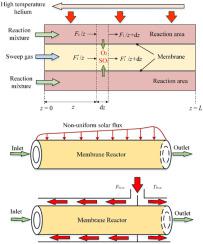当前位置:
X-MOL 学术
›
Energy Rep.
›
论文详情
Our official English website, www.x-mol.net, welcomes your
feedback! (Note: you will need to create a separate account there.)
Entropy generation rate minimization for sulfur trioxide decomposition membrane reactor
Energy Reports ( IF 4.7 ) Pub Date : 2022-01-06 , DOI: 10.1016/j.egyr.2021.11.268 Rui Kong 1 , Lingen Chen 2, 3, 4 , Shaojun Xia 1 , Penglei Li 1 , Yanlin Ge 2, 3, 4
Energy Reports ( IF 4.7 ) Pub Date : 2022-01-06 , DOI: 10.1016/j.egyr.2021.11.268 Rui Kong 1 , Lingen Chen 2, 3, 4 , Shaojun Xia 1 , Penglei Li 1 , Yanlin Ge 2, 3, 4
Affiliation

|
Sulfuric acid decomposition is the critical reaction in sulfur-iodide thermochemical cycle to produce oxygen. Sulfuric acid can decompose spontaneously into sulfur trioxide (SO) and water, and SO continues to decompose into oxygen and sulfur dioxide. The application of membrane reactor can effectively improve the conversion rate of SO and thermal efficiency of sulfur-iodide cycle. The decomposition of SO requires the absorption of a large amount of heat due to its highly endothermic properties, and there are many irreversible processes such as heat transfer, mass transfer, chemical reaction and friction flow in the SO membrane reactor. Therefore, it is necessary to conduct thermodynamic analysis and optimization of the decomposition process to reduce the irreversible loss of the membrane reactor system. In this paper, a finite time thermodynamic model of SO decomposition membrane reactor is established, and the kinetic parameters of decomposition reaction are deduced and calculated based on experimental data. Firstly, the membrane reactor heated by hot helium gas is solved and used as reference reactor. Secondly, optimal control theory is used to optimize the reference reactor under fixed reactant inlet conditions and outlet conversion rate with total entropy generation rate minimization as optimization objective. The total entropy generation rate of Opt-1 reactor is reduced by 32.7% compared with the reference value. For variable reactor length, the total entropy generation rate of Opt-2 reactor is quadratic optimum at m, which is 34.7% less than the reference value. It is found that the reduction of total entropy generation rate in optimal reactors is mainly achieved by minimizing the entropy generation rate in heat transfer process. The distribution of local entropy generation rate is relatively uniform in the middle position, approximately consistent with the principle of equalization of entropy production rate. The conclusions obtained herein can provide guidelines for the energy-saving design of SO decomposition membrane reactors.
中文翻译:

三氧化硫分解膜反应器熵产率最小化
硫酸分解是硫碘热化学循环中产生氧气的关键反应。硫酸能自发分解为三氧化硫(SO)和水,SO继续分解为氧气和二氧化硫。膜反应器的应用可以有效提高SO的转化率和硫碘化物循环的热效率。由于其高吸热特性,SO的分解需要吸收大量的热量,并且SO膜反应器中存在传热、传质、化学反应和摩擦流动等许多不可逆过程。因此,有必要对分解过程进行热力学分析和优化,以减少膜反应器系统的不可逆损失。本文建立了SO分解膜反应器的有限时间热力学模型,并根据实验数据推导计算了分解反应的动力学参数。首先,解决了由热氦气加热的膜反应器并用作参考反应器。其次,采用最优控制理论,以总熵产生率最小为优化目标,在固定反应物入口条件和出口转化率下对参考反应器进行优化。 Opt-1反应堆总熵产率较参考值降低了32.7%。对于可变反应器长度,Opt-2反应器的总熵产生率在m处呈二次最优,比参考值低34.7%。研究发现,优化反应器中总熵产生率的降低主要是通过最小化传热过程中的熵产生率来实现的。局部熵产生率分布在中间位置比较均匀,大致符合熵产生率均衡的原理。本文得出的结论可为SO分解膜反应器的节能设计提供指导。
更新日期:2022-01-06
中文翻译:

三氧化硫分解膜反应器熵产率最小化
硫酸分解是硫碘热化学循环中产生氧气的关键反应。硫酸能自发分解为三氧化硫(SO)和水,SO继续分解为氧气和二氧化硫。膜反应器的应用可以有效提高SO的转化率和硫碘化物循环的热效率。由于其高吸热特性,SO的分解需要吸收大量的热量,并且SO膜反应器中存在传热、传质、化学反应和摩擦流动等许多不可逆过程。因此,有必要对分解过程进行热力学分析和优化,以减少膜反应器系统的不可逆损失。本文建立了SO分解膜反应器的有限时间热力学模型,并根据实验数据推导计算了分解反应的动力学参数。首先,解决了由热氦气加热的膜反应器并用作参考反应器。其次,采用最优控制理论,以总熵产生率最小为优化目标,在固定反应物入口条件和出口转化率下对参考反应器进行优化。 Opt-1反应堆总熵产率较参考值降低了32.7%。对于可变反应器长度,Opt-2反应器的总熵产生率在m处呈二次最优,比参考值低34.7%。研究发现,优化反应器中总熵产生率的降低主要是通过最小化传热过程中的熵产生率来实现的。局部熵产生率分布在中间位置比较均匀,大致符合熵产生率均衡的原理。本文得出的结论可为SO分解膜反应器的节能设计提供指导。











































 京公网安备 11010802027423号
京公网安备 11010802027423号